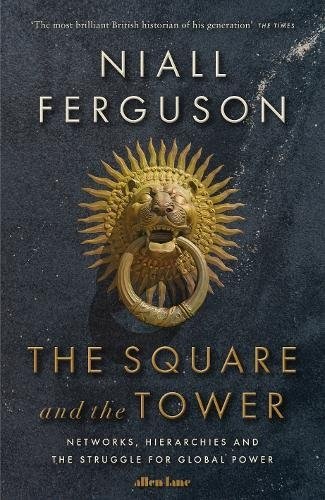Niall Ferguson: The Square and the Tower review - of groups and power | reviews, news & interviews
Niall Ferguson: The Square and the Tower review - of groups and power
Niall Ferguson: The Square and the Tower review - of groups and power
Meditations vertical and horizontal on history and politics, control and communication

The controversial historian Niall Ferguson is the author of some dozen books, including substantial narratives of the Rothschild dynasty, a history of money, and a study of Henry Kissinger up to and including the Vietnam war.
We are given to conspiracy theories, but Ferguson goes well beyond exploding such myths – we are just not efficient, consistent, determined, concentrated nor skilled enough at communication to make sustained conspiracies work – while concentrating on groups that influence events or even instigate them. His title encapsulates what he sees as the different ways power, and decision-making is disseminated: the square, the market place, the centre of the town where people meet and mingle informally on a level space, set against the tower, where those at the top control those at the lower levels.
 The inspiration comes from 14th century Siena, from its Piazza del Campo to the Palazzo Publico, punctuated by the soaring Torre del Mangia. He quotes the observation that, in the 21st century, the Internet is the public square. Frighteningly, as further evidence continues to emerge of the manipulative skill with which some are able to skew the World Wide Web towards the information that they wish to disseminate, such a non-hierarchical cyberspace seems more mythic than real. Indeed has the public square – the Internet – metamorphosed into the tower? This is a stimulating way to think of connections, and is the hook that holds the book together – just.
The inspiration comes from 14th century Siena, from its Piazza del Campo to the Palazzo Publico, punctuated by the soaring Torre del Mangia. He quotes the observation that, in the 21st century, the Internet is the public square. Frighteningly, as further evidence continues to emerge of the manipulative skill with which some are able to skew the World Wide Web towards the information that they wish to disseminate, such a non-hierarchical cyberspace seems more mythic than real. Indeed has the public square – the Internet – metamorphosed into the tower? This is a stimulating way to think of connections, and is the hook that holds the book together – just.
What follows is a sweeping narrative told in a series of vignettes, many pithy and short, looking at groups of all kinds: in fact, it acts as a history of the past several millennia but with constantly changing emphases. Ferguson begins his discursive book – it is organised in 60 chapters, at times chronological, at times skipping about from century to century – with the secret society the Illuminati, which was founded in the 1770s and more or less centred in Bavaria, lasted just over a decade, and thought it could change the world. The Illuminati were progressive in the modern meaning of the word, anti-religious and anti-hierarchical, and although disbanded their enlightened ideas were thought to be connected with the French Revolution, for both good and ill.
But the reader can soon abandon Ferguson’s thesis, which seems self-evident, to simply enjoy succinct and informative essays on, among other subjects, the French Revolution (in the chapter “From Crowd to Tyranny”), the House of Rothschild, Stalin (definitely hierarchical, de haut en bas), and that semi-forgotten but fearsome terrifyingly anti-liberal “imperial warrior” Sir Walter Walker, the inventor of networked warfare. Diversity is the name of the game: there is also a short touching essay on the encounter between Isaiah Berlin and the poet Anna Akhmatova in Leningrad in 1945.
This way of organising historical material is enjoyable, illuminating and at times thought-provoking - what is a network, what a hierarchy? - but not a blinding insight
The whole is fun to read, full of all sorts of sideswipes and sidelines, but curiously lacking in depth. The organising principle – the attempts to discern the differences between groups – doesn’t tell us anything we did not know, even if we were unaware of the specificities of Ferguson’s choice of historical illustrations. We know from our own lives quite a bit about groups and how they change: the schools and universities where we make all kinds of connections, some lasting, some not; our mentors and jobs we have had, families we come from and families we have joined; people and institutions that have had power over us, and where we have seemed to have freely exercised choices or not, about both networks and hierarchies.
We know in the 21st century from our own experiences the uncontrolled wayward power the Internet can exercise; we know about the victims of gossip, the power of the media, so in that fundamental sense Ferguson’s exploration of the influences of different kinds of groups is surprising only in the fascination of his sequence of stories. Basically Ferguson is finding a fresh way to reorganise and present a great deal of material about groups of all kinds – covert, overt, organised, accidental – as a handle for grasping the motivations, machinations and catalysts behind known historical events. What he has produced is a kind of ultimate coffee-table history, one that is very satisfying to dip into (and sometimes no less so, out of). You will learn a lot – but not a fundamentally new way of looking at past and present.
This way of organising historical material is enjoyable, illuminating and at times thought-provoking – what is a network, what a hierarchy? – but not a blinding insight. Nor does he tell us enough about leadership, in spite of a masterly essay on George Soros and his undermining of sterling. What are the ways in which groups are activated and animated, sustained and successful, and how do they fail? Nor is the struggle for global power fully illuminated: struggle implies opposing sides, defeats and victories, which are not explicated.
But his descriptions and analyses of that most fearsome grouping of all in world history, one invented only in recent decades and dispersed under an umbrella of wide-ranging idealism, are substantial and scary. The combinations of the Internet – from Google and Facebook to YouTube and Twitter, not to mention its enablers, Apple and Microsoft – are a perfect example of the law of unintended consequences. (There is a surprisingly affecting photograph of Steve Jobs and Bill Gates together in 1991: they were even born in the same year, 1955.) His final image is unnervingly powerful: the horizontality of the world’s public square, the new architecture of the various campuses of Silicon Valley, and the verticality of Trump Tower, where even the numbering of the floors is faked.
There is that old cliché about history, Toynbee’s “just one damn thing after another”. The Square and the Tower might be said to be about "just one damn group after another", a series of anecdotes – very superior undergraduate essays – put together by an historian who is at times a master story-teller, at times not.
- The Square and the Tower by Niall Ferguson (Allen Lane, £25)
- Read more book reviews on theartsdesk
rating
Share this article
The future of Arts Journalism
You can stop theartsdesk.com closing!
We urgently need financing to survive. Our fundraising drive has thus far raised £49,000 but we need to reach £100,000 or we will be forced to close. Please contribute here: https://gofund.me/c3f6033d
And if you can forward this information to anyone who might assist, we’d be grateful.

Subscribe to theartsdesk.com
Thank you for continuing to read our work on theartsdesk.com. For unlimited access to every article in its entirety, including our archive of more than 15,000 pieces, we're asking for £5 per month or £40 per year. We feel it's a very good deal, and hope you do too.
To take a subscription now simply click here.
And if you're looking for that extra gift for a friend or family member, why not treat them to a theartsdesk.com gift subscription?
more Books
 'We are bowled over!' Thank you for your messages of love and support
Much-appreciated words of commendation from readers and the cultural community
'We are bowled over!' Thank you for your messages of love and support
Much-appreciated words of commendation from readers and the cultural community
 Joanna Pocock: Greyhound review - on the road again
A writer retraces her steps to furrow a deeper path through modern America
Joanna Pocock: Greyhound review - on the road again
A writer retraces her steps to furrow a deeper path through modern America
 Mark Hussey: Mrs Dalloway - Biography of a Novel review - echoes across crises
On the centenary of the work's publication an insightful book shows its prescience
Mark Hussey: Mrs Dalloway - Biography of a Novel review - echoes across crises
On the centenary of the work's publication an insightful book shows its prescience
 Frances Wilson: Electric Spark - The Enigma of Muriel Spark review - the matter of fact
Frances Wilson employs her full artistic power to keep pace with Spark’s fantastic and fugitive life
Frances Wilson: Electric Spark - The Enigma of Muriel Spark review - the matter of fact
Frances Wilson employs her full artistic power to keep pace with Spark’s fantastic and fugitive life
 Elizabeth Alker: Everything We Do is Music review - Prokofiev goes pop
A compelling journey into a surprising musical kinship
Elizabeth Alker: Everything We Do is Music review - Prokofiev goes pop
A compelling journey into a surprising musical kinship
 Natalia Ginzburg: The City and the House review - a dying art
Dick Davis renders this analogue love-letter in polyphonic English
Natalia Ginzburg: The City and the House review - a dying art
Dick Davis renders this analogue love-letter in polyphonic English
 Tom Raworth: Cancer review - truthfulness
A 'lost' book reconfirms Raworth’s legacy as one of the great lyric poets
Tom Raworth: Cancer review - truthfulness
A 'lost' book reconfirms Raworth’s legacy as one of the great lyric poets
 Ian Leslie: John and Paul - A Love Story in Songs review - help!
Ian Leslie loses himself in amateur psychology, and fatally misreads The Beatles
Ian Leslie: John and Paul - A Love Story in Songs review - help!
Ian Leslie loses himself in amateur psychology, and fatally misreads The Beatles
 Samuel Arbesman: The Magic of Code review - the spark ages
A wide-eyed take on our digital world can’t quite dispel the dangers
Samuel Arbesman: The Magic of Code review - the spark ages
A wide-eyed take on our digital world can’t quite dispel the dangers
 Zsuzsanna Gahse: Mountainish review - seeking refuge
Notes on danger and dialogue in the shadow of the Swiss Alps
Zsuzsanna Gahse: Mountainish review - seeking refuge
Notes on danger and dialogue in the shadow of the Swiss Alps
 Patrick McGilligan: Woody Allen - A Travesty of a Mockery of a Sham review - New York stories
Fair-minded Woody Allen biography covers all bases
Patrick McGilligan: Woody Allen - A Travesty of a Mockery of a Sham review - New York stories
Fair-minded Woody Allen biography covers all bases
 Howard Amos: Russia Starts Here review - East meets West, via the Pskov region
A journalist looks beyond borders in this searching account of the Russian mind
Howard Amos: Russia Starts Here review - East meets West, via the Pskov region
A journalist looks beyond borders in this searching account of the Russian mind

Add comment